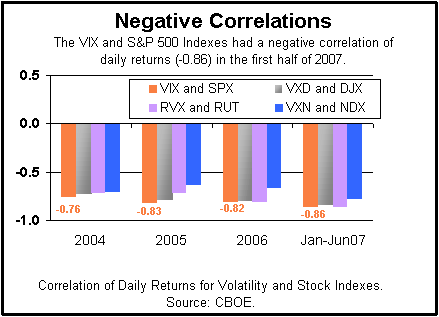Volatility Index Options Menu Expands: VXN and RVX Options Now Available
When I started this blog, one of the reasons I decided to call it “VIX and More” was that unlike other options indices, it was possible to trade VIX options. Well…I won’t be renaming the blog, but as of yesterday, the CBOE is now trading options on the VXN (NASDAQ-100 Volatility Index) and RVX (Russell 2000 Volatility Index.)
I reported on this development when it was first announced and recently offered up some graphs on comparative performance of the major US volatility indices, but clearly it is time to update the full volatility options tree.
With the new VXN and RVX options, the

Additionally, the CBOE has added a new splash page for all five of the volatility indices, which I have pinned to the upper right hand corner of the blog.
The CBOE has also used the occasion of the launch of options on the VXN and RVX to provide some data on these indices that may be of interest to readers. I found it particularly interesting that in terms of activity in the futures (launched July 6, 2007), investors have so far favored the RVX to the VXN by a large margin:

Perhaps related to the above, while a graphic published by the CBOE shows that the VIX has a stronger (negative) correlation to the SPX than do the other volatility indices to their counterparts, it also seems that the relationship between the RVX and the RUT is stronger than that of the VXN and the NDX:

Finally, those interested in implied volatility for the new options can click on the RVX and VXN links to get the appropriate information and graphs from iVolatility.com. From a historical volatility perspective, these two indices look fairly similar at the moment, but I will keep a close eye on them going forward and report any noteworthy divergences.


2 comments:
I've been pondering why the relative disinterest in the VXN futures, and also why the spot VIX was at a lower level than that of the VIX recently (for a short period of time).
I think that maybe those who would normally be interested in hedging tech-heavy portfolios just aren't right now, or they're using broader-market instruments to hedge. In the late stages of a tech rally, this would tend to make me worry, but for now, it could mean that the tech bulls are back. It seems to me that the NDX has been stronger than the SPX for a while.
Bid-ask spreads on the VXN and RVX options are kinda wide right now, so I probably won't be trading them until they tighten up. I was thinking of maybe selling some VXN options against my VIX positions, but why complicate things? :)
XLI looking awfully toppy, i give it one or two more up days, and then you had better buy some QID AND VIX, as a hedge.
If XLI is to succeed in going higher, DOW must clear 14,100....
zee
Post a Comment